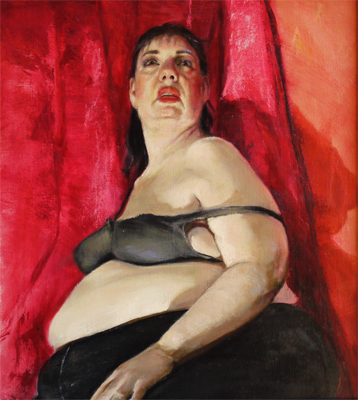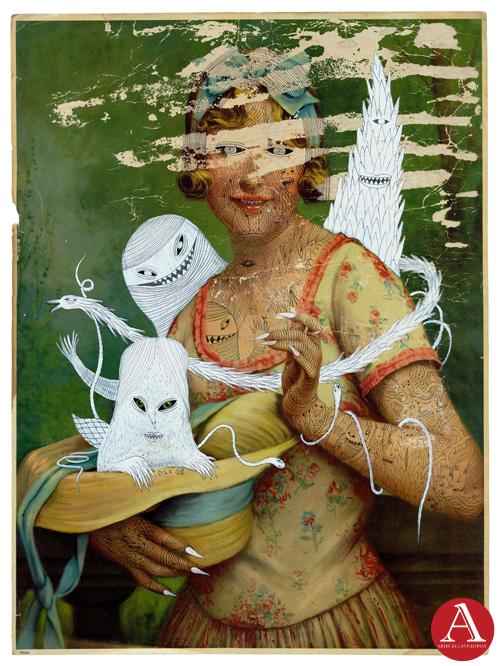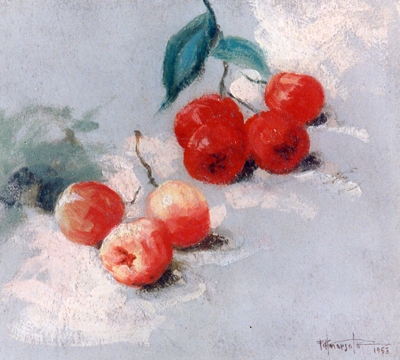
Fernando Amorsolo
“Ang Macopa” (Still Life)
Oil on Board
9’ x 9.5’
1953
Amaryllis Torres Collection
ART COLLECTOR: AMARYLLIS TORRES
by: Christiane L. de la Paz
A former Vice Chancellor for Academic Affairs at the University of the Philippines, currently Professor of Community Development, consultant, trainor, gender equality advocate, and head of various civic organizations, Amaryllis Torres or Amar takes all these roles in stride and embraces them with a grace that only a few could manage. But among the many roles she has had in her life, the one that she is proudest of is her being a mother to four highly successful children and a grandmother to six adorable grandchildren. Now leading a quiet and simple life with her ever growing family, Torres welcomes me into a house filled with kids, art, color, and creativity.
In the idyllic surroundings she fashioned for her children and grandchildren to enjoy, it is easy to understand how even mundane activities can be such a pleasure. Amar has created for them an environment that truly reflects her love for the arts and simple things that she collected through all her different roles in life. Amar says, “My mother fostered my love for the arts. Ever since I was a little girl I have had a deep appreciation for the arts. When I had children of my own, I taught them to love art by bringing them to art museums during our family trips here and abroad. It’s always a part of learning about something. Here, however, they can just take a look around our house and they will learn to appreciate art somehow or the other.”
Amar recalls that the art prints brought home by her mother from the Louvre and Smithsonian Museums familiarized her with the works of the world’s greatest painters and sculptors. She then learned the basic elements of design from her humanities class in college. From her travels to Europe, America, and Asia, she gained a deeper understanding of the different cultures, which broadened her understanding and appreciation for the arts, and heightened her sense of style. It should come as no surprise then that Amar would understand the finer points of art. She has incorporated so much of what she has learned and experienced into her personal values, and these have inspired in many ways the collection she has slowly built over the years with her husband.
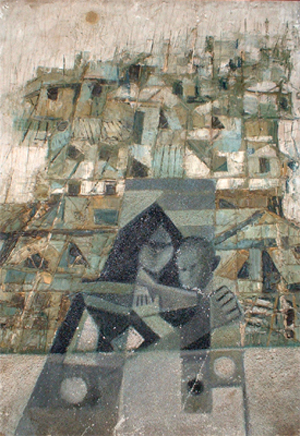
Ricardo Sumilang
“Madonna of the Shanties”
Mixed Media
49 x 34
ca. 1960
Amaryllis Torres
She says that her odyssey to art collecting was a “journey I started with my husband.” “My first painting was the “Madonna of the Shanties” done by a friend of my husband, Ricardo Sumilang, a Shell Art Contest finalist in the early ‘sixties who passed away and did not attain prominence. It was a gift to my husband because he and Ric Sumilang were in the same organization when they were students in the University of the Philippines. The second one I bought was a painting done by a 10-year old girl, which I acquired from the Children’s Museum and Library, at a time when Fernando Sena was doing summer workshops for children and my son was one of his students. He exhibited some of the best works done by his students at that time. This painting very much appealed to me. It was coincidental that it was again a Madonna and Child done in pointillism. I was so fascinated that a 10-year old girl could apply the technique so well in a canvas that is relatively huge,” she says with a smile.
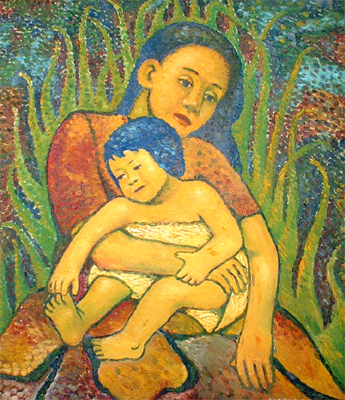
Onsiaco
“Mother and Child”
Oil on Canvas
27 x 23 ¼
undated
Amaryllis Torres Collection
These two paintings she acquired from the early stage of her marriage were indicative of the affection she has towards art, but she had to put this on hold to devote her time and resources to raising a family. Many years have passed and her love for the arts was resurrected when her former professor in English, Nieves Epistola, persuaded her to attend art exhibits sponsored by the Heritage Arts Gallery in the University if the Philippines campus. Her temporary respite fell away when she considered buying a still life painting of Norma Belleza. “I was fascinated with Norma Belleza’s use of vibrant colors and composition. This painting I have of hers is a still life of flowers and fruits, arranged in a casual fashion. It was just a coincidence that it melds flawlessly with the arrangement of our dining area. It is hard to beat the charm it has brought to the room. And then, to my utter joy and amazement, I discovered that it is one in a series that she completed in the ‘90s, since a similar painting hangs in the Conference Room of Benguet Mining Corporation in Ortigas Center!”
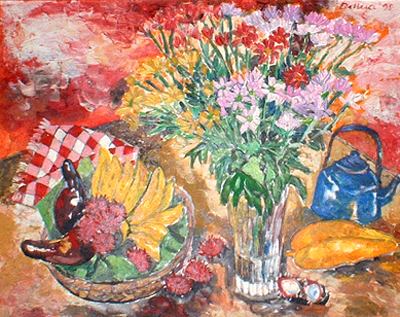
Norma Belleza
“Still Life”
Oil on Canvas
18’ x 24’
1992
Amaryllis Torres Collection
Amar followed this piece with other works done by female artists which include, among others, Anita Magsaysay Ho, Araceli Dans, Arlene Villaver, Lydia Ingle, Sandra Torrijos, Hannah Liongoren, Pacita Abad, Fatima Baquiran, Inday Cajipe-Andaya, and Gilda Cordero-Fernando. Amar explains that in the latter part of her life, she has spent considerable time fighting for women’s causes, and part of her advocacy was “to make women’s talent more visible.”

Pacita Abad
“Are You In Bad Mood”
Oil pastel, acrylic, glitters
30’ x 30’
1990
Amaryllis Torres Collection
Amar’s eyes are naturally drawn to “anything that appeals to my aesthetic sense.” She concentrates less on art that are baffling or unnerving or belligerent. “I do not like anything that makes me feel depressed, so I prefer to have paintings that elevate my spirit or make me feel meditative.” Her eyes glow when she watches all her collection unfold in the many places that she has put them. “Every time I look at what I’ve collected over the years, they never cease to inspire me. I have always been fascinated with the idea that someone can paint ordinary living things and make them appear beautiful, magical, and important. It certainly is interesting to see someone who uses his or her imagination to look at reality in the things that are easily not conceived by my sensory ability. That alone explains why, no matter how busy I am, I still manage to go to exhibits, read books and articles on art, and visit galleries from time to time. The arts just happen to be something that I value,” she shares.
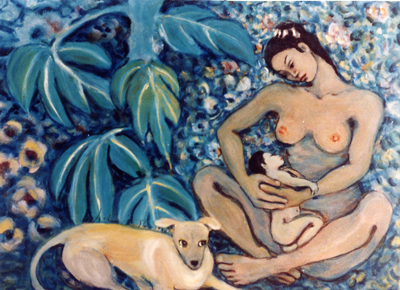
Lydia Ingle
Papaya Mother and Child
Oil on Canvas
20 x 26.5
1994
Amaryllis Torres Collection
“Norma Liongoren, a friend and a contemporary in college was a great help in looking for some of the art works I acquired. She has helped me arranged my art works to give each piece its own character and at the same time tie the rooms together.” For her part, Amar tried to create a subtle yet romantic and warm feeling in the arrangement of her collection. “My idea was to give my art collection a sense that it belonged in the setting and had been there for so long that it was one with the house,” she says.
Happily ensconced in a house she has called home for the last decade or so, Amar provided the opportunity to show some of the more powerful paintings in her collection. The living room has become a gallery of paintings by some of the best Filipino artists. One wall is dominated by a diptych oil painting by National Artist H.R. Ocampo. To its left and right are abstracts rendered by Nestor Vinluan and Ibarra de la Rosa. Placed over the piano is a very old painting by National Artist Victorio Edades. But her perennial favorite remains an oil-on-board painting of National Artist Fernando Amorsolo entitled “Ang Macopa.” “What makes this piece special is that it was not the usual lady by the river or another one of Amorsolo’s usual genre scenes, but simply a still-life rendition in oil of macopa fruits done in a very effortless style that exudes an old charming feeling.”

Victorio Edades
Untitled
Oil on canvas
8.75’ x 14. 5’
undated (ca. early 80s)
Amaryllis Torres Collection
An equally impressive ensemble of works by National Artists Cesar Legaspi, Vicente Manansala, and Ang Kiukok is likewise represented. She points out to me an unusual painting of National Artist Ang Kiukok. “This painting of an aloe vera is extraordinarily unique, hardly associated with the themes illustrated in most of Ang Kiukok’s works. It embodies beauty and serenity and surprises anyone who finds out that it is an Ang Kiukok painting,” Amar observes, “Sometimes, it is also good to collect works of artists through the different periods of their painting styles.”

Ang Kiukok
“Aloe Vera”
Watercolor
14’ x 19’
1981
Amaryllis Torres Collection
Her painting collection is further enlivened by a mix of Philippine antique and Italian furniture and numerous old-charm collectibles ranging from baccarat and Lalique crystals, to Murano and Lladro figurines. Different kinds of hand-made potteries, including the work of John Pettyjohn and Lanelle Abueva, produce a dazzling array of ceramic art. Her limited edition of print and plate collections give her surroundings a personal stamp of creativity and a sense of history. Not to be missed as well is a flower clock, a gift to her by young sculptor Jenny Cortez. This installation art piece not only displays time but reproduces the beauty of an amaryllis flower in bloom. Table and chairs designed by furniture artist Benjie Reyes showcases the unique qualities and all-out possibilities of wood.
Ancient and ethnic art forms ranging from baskets to textiles to bulols (rice gods) to archaeological diggings of decorative jars, cut glass flower vases, and porcelain plates, provide significant and highly important evidences of the past. A wooden mural and a bronze sculpture from National Artist Napoleon Abueva occupy prominent places at the core of her collection. “Abueva is one of the most prolific sculptors we’ve had and his work spans from abstracts to forms. What I like best about Abueva is that he is able to glorify the Filipino people in most of his works.”
She ends with a cherished dream that in the distant future, the Philippines will continue to produce a prolific set of artists for the rest of the world to witness the Filipino’s talent and creativity. “Whether or not they make it to the international scene is beside the point. There are many well-known Filipino artists whose works are recognized and adored here and abroad. Just knowing that we have a vast number of talented artists and traditional artisans is enough for me. This is something that I can be proud of as a Filipino.”



